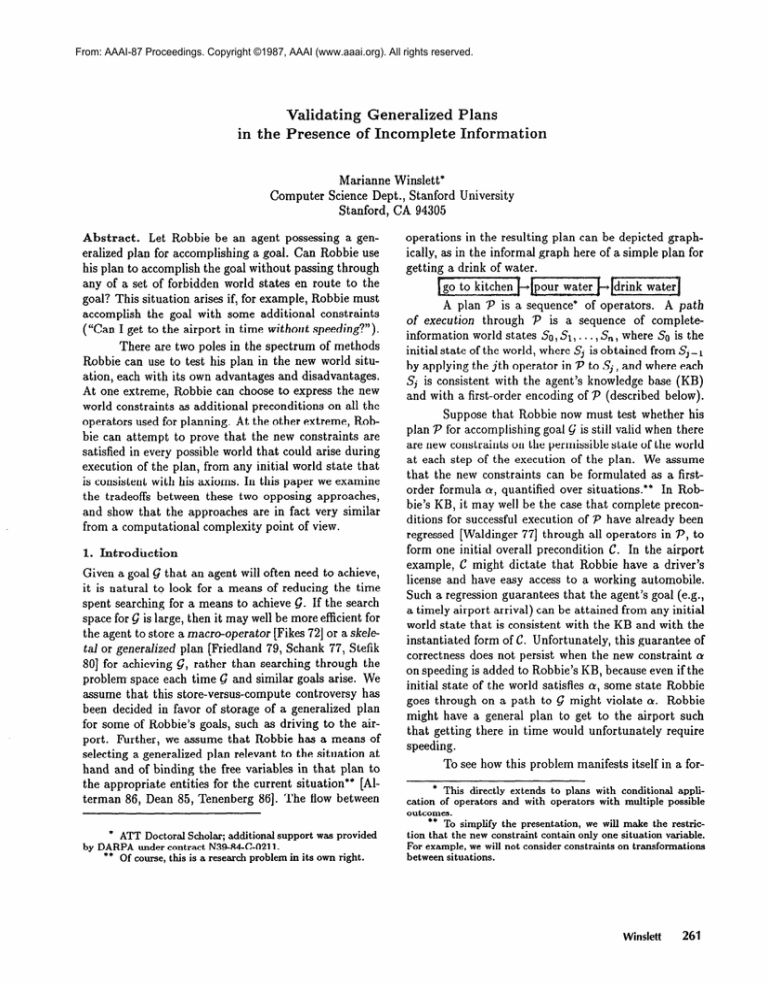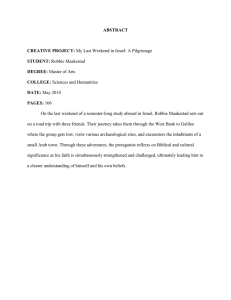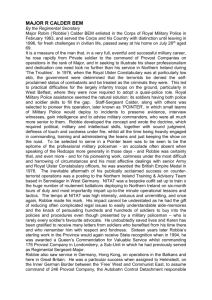
From: AAAI-87 Proceedings. Copyright ©1987, AAAI (www.aaai.org). All rights reserved.
Validating Generalized Hans
in the Presence of Incomplete Information
Marianne Winslett*
Computer
Science Dept., Stanford University
Stanford, CA 94305
Abstract.
Let Robbie be an agent possessing a generalized plan for accomplishing a goal. Can Robbie use
his plan to accomplish the goal without passing through
any of a set of forbidden world states en route to the
goal? This situation arises if, for example, Robbie must
accomplish the goal with some additional constraints
(“Can I get to the airport in time without speeding?“).
There are two poles in the spectrum of methods
Robbie can use to test his plan in the new world situation, each with its own advantages and disadvantages.
At one extreme, Robbie can choose to express the new
world constraints as additional preconditions on all the
operators used for planning. At the other extreme, Robbie can attempt to prove that the new constraints are
satisfied in every possible world that could arise during
execution of the plan, from any initial world state that
is consistent with his axioms. In this paper we examine
the tradeoffs between these two opposing approaches,
and show that the approaches are in fact very similar
from a computational complexity point of view.
I. htrodiaction
Given a goal 5: that an agent will often need to achieve,
it is natural to look for a means of reducing the time
spent searching for a means to achieve S. If the search
space for G is large, then it may well be more efficient for
the agent to store a macro-operator [Fikes 721 or a skeletal or generalized plan (Friedland 79, Schank 77, Stefik
801 for achieving G, rather than searching through the
problem space each time G and similar goals arise. We
assume that this store-versus-compute
controversy has
been decided in favor of storage of a generalized plan
for some of Robbie’s goals, such as driving to the airport. Further, we assume that Robbie has a means of
selecting a generalized plan relevant to the situation at
hand and of binding the free variables in that plan to
the appropriate entities for the current situation** [Alterman 86, Dean 85, Tenenberg 861. The flow between
* ATT Doctoral Scholar; additional support was provided
by DARPA under contract N39-84-C-0211.
** Of course, this is a research problem in its own right.
operations in the resulting plan can be depicted graphically, as in the informal graph here of a simple plan for
getting a drink of water.
A plan P is a sequence* of operators.
A path
through P is a sequence of completeinformation world states So, 5’1, . . . , S,, , where So is the
initial state of the world, where Sj is obtained from Sj-1
by applying the jth operator in P to Sj , and where each
Sj is consistent with the agent’s knowledge base (MB)
and with a first-order encoding of P (described below).
of execution
Suppose that Robbie now must test whether his
plan P for accomplishing goal G is still valid when there
are new constraints on the permissible state of the world
at each step of the execution of the plan. We assume
that the new constraints can be formulated as a firstorder formula c~, quantified over situations.** In Robbie’s KB, it may well be the case that complete preconditions for successful execution of P have already been
regressed [Waldinger 771 through all operators in P, to
form one initial overall precondition C. In the airport
example, C might dictate that Robbie have a driver’s
license and have easy access to a working automobile.
Such a regression guarantees that the agent’s goal (e.g.,
a timely airport arrival) can be attained from any initial
world state that is consistent with the KB and with the
instantiated form of 6. Unfortunately, this guarantee of
correctness does not persist when the new constraint o
on speeding is added to Robbie’s KB, because even if the
initial state of the world satisfies Q, some state Robbie
goes through on a path to G might violate (Y. Robbie
might have a general plan to get to the airport such
that getting there in time would unfortunately require
speeding.
To see how this problem manifests itself in a for* This directly extends to plans with conditional application of operators and with operators with multiple possible
outcomes.
** To simplify the presentation, we will make the restriction that the new constraint contain only one situation variable.
For example, we will not consider constraints on transformations
between situations.
Winsleta
261
malization of Robbie’s plan, let us introduce some terminology that will be used throughout the remainder
of this paper.
We have already described P and C,
forms of a generalized plan and its overall precondition.
The new constraint is denoted by a. Situation variables and constants are written s, s’, se, si, etc. The
situation describing the initial state of the world is so;
Note that SOneed not completely specify the state of the
world; So is a complete-information
world state consistent, with all knowledge about SO. The result of applying
the first operator in P to SO is situation s1 (e.g., si =
and so on until situation s,,
result(startUpCar(s0)));
the final result of the plan, is defined.* The definitions
of SO through sn constitute an encoding of P. For any
world state Si on a path of execution through P, the situation corresponding
to Si is situation si. Finally, for
any formula 4 with a single quantified situation variable
x, let +[s] be the formula created by binding x to the
constant s.
We now give a definition of plan validity. Assume
For P to be valid
that C[sc] is true (e.g., lspeeding(se)).
given the new constraint CX,cp must be satisfied at every
world state along every path of execution through P.
More formally, P is valid in the presence. of the new
constraint QI if C[sc] is true, and for every world state
Si along every path of execution through P, o[si] is
true. Of course, one cannot prove validity by testing
each possible Si separately, because the combinatorial
possibilities are computationally
overwhelming.
To check the validity of P more efficiently, it
might seem to suffice to check whether G is true in situation sn -for example, to check whether Robbie arrived
at the airport in time. Unfortunately, this is insufficient;
as long as C[sc] is true, G[s,J will be also.
For example, suppose that Robbie has a plan to
conquer his thirst during dinner by getting a drink of
water, as shown above. This can be represented in a
simplified portion of Robbie’s KB by using four predicates to describe the state of the world: atBldg(bldg,
sitn), inRoom(room,
sitn), thirsty(sitn), has(item, sitn);
three plan operators:
goToKitchen,
pour, drink; and
frame axioms telling what aspects of world state are
not affected by application of operators. The resulting
KB fragment appears in Figure I.**
Initial situation:
thirsty(sc)
inRoom( diningRoom,
SO)
Operators:
Vs inRoom(kitchen,
result(goToKitchen,
s))
Vs [inRoom(kitchen,
s) --) has(water, result(pour,
V’s [has(water, s) --) (1 thirsty(result(drink(s)))
lhas(water,
result(drink(s))))]
s))]
A
Frame axioms:
Vs [thirsty(result(goToKitchen,
s)) *
V’s Vx [has(x, result(goToKitchen,
Vs Vx [atBldg( x, result(goToKitchen,
atBldg(x, s)]
Vs [thirsty(result(pour,
thirsty(s)]
s)) *
has(x,
s)]
s)) ++
s)) cf thirsty(s)]
V’s Vx [x # water 3
(has(x, result(pour, s)) w has(x, s))]
V’s Vx [x # water
(has(x, result(drink,
+
s)) *
has(x, s))]
(other frame axioms showing that atBldg and inRoom
are unaffected by pouring and drinking)
Additional
axioms:
Vs Va: Vy [(atBldg(x,
s) A atBldg(y,
Vs Vx Vy [(inRoom(x,
Figure 1. Simplified
s) A inRoom(y,
s)) -
x = y]
s)) -
x = y]
portion of agent’s KB.
Then Rosie asks Robbie if he knows how to get
water during dinner with the additional constraint that
in a restaurant, Robbie should never be in the kitchen.
The new constraint and the resulting encoding of plan
P are shown in Figure 2.
Encoding
of plan P:
Sl = result(goToKitchen,
s2 = result(pour,
s3 = result(drink,
New constraint
~2)
Q:
Vs[atBldg(restiant,
Instantiated
so)
si)
s) +
linRoom(kitchen,
s)]
goal G[sn]:
-&hirsty(ss)
Figure 2. Plan to quench thirst, and a new constraint.
* A similar coding using conditionals can be used for plans
with non-sequential structure.
** This is certainly not intended as a definitive or prescrip
tive encoding of thirst-quenchery; rather, it is a simple encoding
that is sufficient for our purposes.
We have omitted some important rules, such as type information, have lazily represented
rooms within buildings as constants rather than functions, and
have simplified the “pour” and “drink” operators.
262
Planning
Is P still valid no matter whether Robbie is at
home or at a restaurant? Obviously not, because there
is one path of execution through P in which Robbie is
in a restaurant kitchen. Let KB+ be Robbie’s KB plus
Q and the encoding of P in Figure 2. Then invalidity of
P cannot be detected by a test for logical consistency
of KB+ , because KB+ is provably logically
Further, KB+ logically implies +hirsty(ss),
not detect invalidity by a test for provability
conclude that, in general, simple checks for
are insufficient to show validity when new
are introduced.
consistent .*
so one canof S.** We
consistency
constraints
In restricted cases, however, a simple check for
consistency does suffice.
If P is completely invalid,
in the sense that every path of execution
through
P passes through a world state that is inconsistent
with c~, then MB+ will be inconsistent.
For example, suppose the KB contains the additional formula
atBldg(restaurant,
SO). From KB+ one can prove, as
SO); hence KB+ is inconsisbefore, latBldg(restaurant,
tent. This implies that P will be valid if (1) the initial
state of the world is completely determined by the KB,
and C[so] is true; (2) all operators in P are deterministic;
and (3) MB+ is consistent. Unfortunately, as shown by
Robbie’s thirst-quenching plan, this approach does not
extend to the common case where unknown, missing, or
incomplete information is relevant to P.
2. Prove-Ahead
and Prow-As-You-Go
Assuming that an agent wishes to validate a plan completely before beginning its execution, there are two
main approaches to an efficient and general means of
plan validation.
The first is to regress constraint CY
through all KB operators to form additional preconditions on those operators. In other words, add additional
preconditions to each operator 0 so that 0 can never be
applied if the resulting situation would violate o. In the
restaurant example, this can be done by adding an additional condition on the goToKitchen operator, so that
Robbie cannot go into the kitchen if he is in a restaurant. We call this the prove-ahead approach, because
we find the possible effects of 0 on cy ahead of time
and act to prevent violations of LY.After this regression
phase is complete, we can test the plan for validity by
either of two methods: either regress to a new overall
plan precondition C’ and check provability of C’[so], or
else step through the plan operations and test whether
the new preconditions of those operators are satisfied at
each stage of execution.
There is a philosophical motivation for the pure
prove-ahead approach, in which all constraints are re* A more reliable sign of trouble is that KB+ logically implies that Rohbie is not in a restaurant in state So. This is because
the path of execution in which Robbie is initially in a restaurant
gets pruned from the tree of possible plan executions, because it
is inconsistent with CV.
** As mentioned earlier, if a KB logically entails C[SO], then
KB+
must logically entail G[s,].
gressed through all KB operators: once a complete regression has been done, any plan where G[s,J is provable
is a valid plan, no matter what the initial world state
and no matter what branching occurs during plan execution. With pure prove-ahead, Robbie need not worry
about detecting constraint violation at plan generation
and validation time; he need only check preconditions.
The alternative to the prove-ahead approach in
this example is to prove that at each situation on a path
of execution through P, Robbie is not in a restaurant
kitchen. More formally, given that axiom <Yis satisfied
in an initial situation SO, one must prove that (Y is also
true in situation ~1. If one can prove a[si] for each
situation sd in the encoding of P, then P is valid. We call
this technique the prove-as-you-go approach, because we
step through the operators of the plan in order, and for
each operator 0 prove that a is true in the situation
that results from applying 0 to the previous situation.
The remainder of this paper is a discussion of
the advantages and disadvantages of the prove-ahead
and prove-as-you-go
approaches.
We show that these
two paradigms are at opposite ends of a spectrum of
approaches, yet are computationally
quite similar.
3. The
Qualification
Problem
Both the prove-ahead and prove-as-you-go
approaches
are methods of dealing with the qualification proHem
[Ginsberg 87, McCarthy 69, McCarthy $01: what preconditions must be met in order for an action to succeed? In the real world, it is impossible to enumerate all
the factors that might cause failure of a plan such as for
a trip to the airport. This means that the philosophical
motivation behind prove-ahead must ultimately be frustrated: except in simple systems, one cannot enumerate
all the prerequisites for an operator. In attempting to
do so, one will simply clutter up the MB with a sea of
inconsequential preconditions for operations, and lower
the intelligibility of the KB for outside reviewers.
Even were an exhaustive list of preconditions
available, one would not in general want to take the
time needed to prove that all the preconditions
were
satisfied. This problem also arises in the prove-as-yougo approach, however; one may not be able to afford
the expense of proving that all constraints will be satisfied after an operation is performed. In section 6, we
will discuss the relative adaptability of prove-ahead and
prove-as-you-go
to partial testing of preconditions and
constraints.
4. A Comparison
of Computational
Coma
The computational
complexity
of prove-ahead
and
prove-as-you-go depends on Robbie’s language and KB.
Winsleti
263
Depending on the form of his KB, testing plan validity
can be in any complexity class: from polynomial time
worst case on up through undecidable. The goal of this
section is not to differentiate between these classes, but
rather to show that prove-ahead and prove-as-you-go
are in the s-e
complexity class for any given type of
KB. We will do this by comparing the requirements that
prove-ahead and prove-as-you-go impose on a theoremprover.
In specific KB and plan instances, prove-asyou-gomay
be less costly than prove-ahead; this is particularly true if the agent is not interested in repairing
invalid plans. Because additional information about the
state of the world may be available at the time an operator in the plan is applied, prove-ahead does not detect
invalidity as quickly as does prove-as-you-go.*
This tardy detection of invalidity arises because
pure prove-ahead requires two rounds of proofs. Robbie
must first regress (Y into new preconditions,
and then
test whether the new preconditions are satisfied during
execution of P. While prove-ahead may make the same
set of calls to a theorem-prover as does prove-as-you-go,
prove-ahead will not discover that P is invalid until the
second phase of its computation, when the new preconditions are checked against world state information.
A
hybrid approach can be used to overcome this flaw in
part, but prove-ahead will still require two rounds of
proofs.
Prove-ahead has another computational
disadvantage when compared with prove-as-you-go,
in that
prove-as-you-go
can take advantage of all the state information available when trying to prove satisfaction of
cr. Prove-ahead, on the other hand, first derives a most
general condition under which (Y will be satisfied, and
then checks to see whether that condition holds in the
situation at hand. For example, consider the constraint
that the car stay on the road at all times while driving.
General preconditions for this condition may be very
difficult to find. On the other hand, it may be trivial to
show that the car is on the road right now; for example,
Robbie may have a primitive robotic function available
that tells him that the car is now in the middle lane.
To elucidate this point further, we describe a method of
implementing prove-ahead and prove-as-you-go.
Let s be a situation on a path of execution
through P, and let s’ be the situation resulting from
applying the next operator 0 in P to situation s. (As
usual, the state of the world in situations s and s’ need
not be fully determined by the KB.) The prove-as-yougo method requires that one prove cy[s’] given cr[s]. If
+A more accurate cost comparison must consider the amortized cost of prove-ahead (section 5).
264
Planning
the proof fails and P is not to be repaired, then the
validation process terminates at this point. If the proof
fails and P is to be repaired, then two repair tactics
are possible: depending on the method used to establish cy[s’], the reason for the failure can be converted into
additional preconditions on operators and/or additional
conditions for C. For example, in many cases verification of a universal constraint cy can be reduced to testing
a number of ground instantiations of CY[Winslett 871. If
any of these ground instantiations is not provable, then
this pinpoints a case in which o is violated. After this
violation is repaired, the process is repeated, searching
for another violation of CYin situation s’.
The prove-ahead method also requires that one
prove cu[s’] given cy[s], with the additional proviso that
s can be any legal situation, not just one on a path of
execution through P. In other words, in attempting to
prove cr[s’], one cannot use any state information about
s that could be deduced from P. Further, failure to
find a proof does not mean that P is invalid; invalidity
can only be ascertained by repairing 0 and then checking its new preconditions against initial world state information.
In addition, prove-ahead requires detection
of all violations of cy[s’] before determining whether P
is valid. For example, a prove-ahead approach to the
restaurant constraint would generate the new precondition +nBuilding(restaurant,
s) for the goToKitchen
operator, even if the first step of Robbie’s plan were to
go home. Finally, once the regression is complete and
any invalidities have been detected, repair of P is accomplished by adding additional constraints to C.
In the worst case the potential computational advantages of prove-as-you-go will not materialize. For example, if there is no helpful state information available
for situation s, then prove-as-you-go
will not have that
advantage over prove-ahead. More precisely, suppose P
contains situations sc through sn, and let Q be the ith
operator of P. Suppose the agent finds a prove-as-yougo proof of a[si] such that that proof does not contain
any sj, for 0 5 j 5 n, other than si and si-1. Then
prove-ahead is as easy as prove-as-you-go
for operator
Qi, as-essentially the same proof may be used for proveahead.
5. Hybrid
Approaches
In general, neither the pure prove-ahead nor the pure
prove-as-you-go
approach will dominate in efficiency; a
hybrid approach will be much more satisfactory.
For
example, there is no need to regress Q through an operator until it is actually used in a plan. Then if (Y is a
temporary constraint (such as a prohibition on speeding
while Rosie is in the
be done.*
4,
a complete regression will not
Regression through the operators in a particular plan is one point in the spectrum between pure
prove-ahead and pure prove-as-you-go,
a hybrid between the two approaches;
such intermediate points
abound. For example, Robbie might deliberately choose
not to regress o through a particular operator 0 even
though 0 appears in the plan at hand; this might be
advisable if cr was a temporary constraint and/or no
plan repair was contemplated.
He might choose proveas-you-go for certain pairs of operators and constraints,
and apply prove-ahead to the remainder.
If Robbie
can predict how often a particular prove-as-you-go proof
would be repeated in the future, he can use measures of
storage cost and other, less tangible factors (see section
6) to estimate the amortized cost of prove-ahead over all
repetitions of that proof [Lenat 793. The amortized cost
of prove-ahead can then be used as a basis for choice
between prove-as-you-go
and prove-ahead.
Robbie need not apply the two phases of proveahead sequentially; the gap between regression and new
precondition testing in prove-ahead can be narrowed
by partial merging of the generation of new preconditions and their testing.
If Robbie begins by regressing (Y through the first operator 0 of his plan, then he
can immediately check to see whether the new preconditions for 0 are true in state SQ. If the preconditions are
not true, then Robbie knows that P is not valid, and
can proceed to repair or else search for another plan.
For even more rapid detection of invalidity, Robbie can
check each new precondition as it is generated. Proveahead will still require two rounds of proofs, however.
Robbie can even choose dynamically
between
prove-ahead and prove-as-you-go.
For example, he can
validate the first few steps of P using prove-ahead, and
then decide, on the basis of the additional information
available at that point, that prove-as-you-go is the best
choice for the remainder of the validation sequence.
6. Comparative
Extensibility
and Prove-As-You-Go
of Prove-Ahead
As described earlier, prove-as-you-go
has a computational advantage over prove-ahead in its use of all state
information available at a stage of plan execution. The
counterpart of this prove-as-you-go
advantage is the
possibility in the prove-ahead world of choosing overly
general preconditions. For example, suppose Robbie has
a constraint on successful driving that the car must stay
on the road at all times. The exact preconditions for
maintaining this constraint at each moment are very
complicated;
they depend on how far Robbie is from
the edge of the road, how fast he is going, etc. It would
be easier to forgo exact preconditions and use a simpler subsuming condition, and run the risk of possibly
rejecting a plan due to too-strict preconditions.
Another disadvantage of prove-ahead is that it
will generate many operator preconditions, and the exact relation of those preconditions to the situational constraints will not necessarily be clear. This has repercussions for Robbie’s ability to explain his decisions to an
outside agent. Robbie will need some means of tagging
preconditions and their associated constraints; this is
a second-order concept. One may well argue that in a
model of human car-starting, unlikely and inconsequential preconditions should not be stored with the operators that they impact. Rather, a human would call on
its deductive facilities in the event that the car failed
to start, to try and trace the origin of the failure to a
combination of unchecked constraints.
This tagging consideration assumes greater importance if we abandon the assumption that Robbie
never makes a move without consulting his theoremprover. For example, Robbie may assign numerical measures of importance to preconditions and constraints,
based on the likelihood of their being violated in the
current situation and on the magnitude of the repercussions of their violation [Finger 861. Then Robbie can
choose which preconditions and constraints to check before performing an action, based on the computational
resources available to him and the importance of the
checks. Rowever, in order to assign measures of importance to preconditions, again it is necessary to tag preconditions and their associated constraints.* Otherwise
the consequences of failing to check a precondition will
be unclear, for without an additional round of proofs,
Robbie cannot easily tell which constraints may be violated if a particular precondition is ignored.
For example, Robbie may decide that it is not
worthwhile to look for a potato in the tail pipe before
turning the ignition key, for violation of this condition
is unlikely, and ignoring it will not have a disastrous
effect on the state of the world anyway. In contrast,
Robbie might check this constraint after a fierce Idaho
could be stored as firstthe KB. Efficient utilizathe use of special control
Winslett
265
rainstorm, or if there had been a recent rash of highly
explosive tailpipe potatoes.
7. Conclusions
Let Robbie be an agent faced with the task of validating
a plan P in the presence of a new constraint (u. If the
initial state of the world is fully determined by information on hand and P is deterministic, then P is valid iff
Robbie’s knowledge base (KB) is consistent with CEand
an encoding of P. However, another means of validation is needed when Robbie has insufficient information
about the current state of the world.
We have identified two extreme approaches to
this validation problem.
In the pure prove-ahead approach, Q! is transformed into additional preconditions
on Robbie’s KB operators, and then the new operator
preconditions for plan P are checked to see if they are
true in the current situation, either by regressing those
conditions or by direct checks. In the pure prove-as-yougo approach, to determine whether P is valid, Robbie
must prove that (Y is true at each step of P, given that
Q holds initially.
The prove-ahead and prove-as-you-go
methods
are computationally
quite similar: for a given type of
KB, they are in the same computational
complexity
class. In practice, prove-as-you-go
may be less costly
than prove-ahead, as its search for violations of (Y has
a narrower focus. For example, any violation of CYdetected by prove-as-you-go may actually arise during the
execution of P; but prove-ahead may locate many potential violations of Q that could not arise in P before
finding those that do. This computational
advantage
arises because prove-as-you-go
can utilize information
about the state of the world that arises from prior operators in the plan. It may be much easier to prove that
a constraint. is satisfied at a particular point in the execution of a plan than to solve the prove-ahead problem
of finding general preconditions for satisfaction of that
constraint.
Pure prove-ahead and pure prove-as-you-go
fall
at two ends of a spectrum; in practice, we expect a
hybrid approach to perform better than either extreme.
In choosing whether to apply prove-ahead or
prove-as-you-go to a particular operator and constraint,
one must consider factors other than simple computational complexity.
Intuitively, the prove-as-you-go
approach is best for “obscure” constraints.
Prove-ahead
is best for constraints that will be checked often, as under prove-as-you-go the same proofs would be performed
time after time.
An informed choice between proveahead and prove-as-you-go must consider the amortized
266
Planning
cost of the two approaches, i.e., consider the number of
times a proof would have to be repeated under prove-asyou-go, and also measure costs of storage, comprehensibility to outside agents, and extensibility to heuristic
methods of planning: the store-versus-compute
tradeoff
once again.
Acknowledgments
This paper arose from discussions of the planning problem with J. Finger, H. Hirsh, L. Steinberg, D. Subramanian, C. Tong, and R. Waldinger, who gave lively
and patient arguments for the merits of and underlying
motivations for the prove-ahead and prove-as-you-go approaches, and suggested directions for extensions.
References
[Alterman 19861 R. Alterman, “An adaptive planner”,
Conference On Artificial Intelligence, 1986.
National
[Dean 851 T. Dean, “Tempoml reasoning involving counterfactuals and disjunctions”, Proceedings of the international Joint
Conference on Artificial Intelligence, 1985.
pikes
721 R. E. Fik es, P. E. Hart, and N. J. Nilsson, “Learning and executing generalized robot plans”, Artificial Intelligence 3:4,#1972.
Finger 861 J. Finger, “Planning and execution with incomplete
knowledge”, unpublished manuscript, 1986.
[Friedland 791 P. E. Friedland, Knowledge-based
experiment design in molecular genetics, PhD thesis, Stanford University,
1979.
[Georgeff 851 M. P. Georgeff, A. L. Lansky, and P. Bessiere, “A
procedural logic”, Proceedings
of the International Joint
Conference on Artificial Intelligence, 1985.
[Ginsberg 871 M. Ginsberg and D. E. Smith,
action I”, submitted for publication.
“Reasoning about
[Lenat 791 D. B. Lenat, F. Hayes-Roth, and P. Klahr, “Cognitive
economy in artificial intelligence systems”, Proceedings of
the International Joint Conference on AI, 1979.
[McCarthy 691 J. McCarthy and P. J. Hayes, “Some philosophical problems in artificial intelligence”, in B. Meltzer and
D. Michie, eels., Machine Intelligence 4, Edinburgh University Press, Edinburgh, 1969.
[1McCarthy SO] J. McCarthy, “C’ncumscription-A
form of nonmonotonic reasoning”, Artificial Intelligence 13, 1980.
[Sacerdoti 771 E. D. Sacerdoti, A structure for plans and behavior,
Elsevier North Holland, New York, 1977.
[Schank 771 R. C. Schank and R. P. Abelson, Scripts, plans, goals,
and understanding, Lawrence Erlbaum, Hillsdale NJ, 1977.
[Stef% SO] M. J. Stefik, Planning
Stanford University, 1980.
with constraints,
PhD thesis,
[Tenenberg 861 J. Tenenberg, “Planning with abstraction”,
tional Conference on Artificial Intelligence, 1986.
Na-
[Wahlinger 771 R. J. Waldinger, “Achieving several goals simultaneously”, in E. W. Elcock and D. Michie, eds., Machine
Intelligence 8, Halstead/Wiley,
New York, 1977.
[Winslett $71 M. Winslett, Updating databases with incomplete
information, PhD thesis, Stanford University, 1987.








